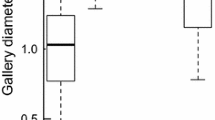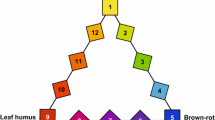Abstract
We studied the biology of the ambrosia beetle Platypus quercivorus in the logs of five tree species to determine: (1) the relationship between the amount of frass produced by beetles and tunnel length, (2) the relationship between frass shape and the morphological characteristics of P. quercivorus mouthparts, and (3) the suitability of five tree species for P. quercivorus reproduction. Five logs each from healthy Quercus crispula, Q. serrata, Castanea crenata, Sorbus japonica, and Cryptomeria japonica trees were used in this experiment. The results showed that there was a linear relationship between the amount of frass and tunnel length. Whenever powdery frass was produced, larvae were found in the gallery in the log, while fibrous frass was present only in galleries that contained just adults. The mouthparts of adults were completely sclerotized, which likely accounts for the fibrous frass production. Host preference of P. quercivorus was examined at two stages using five tree species. The first stage is digging initiation, which concerns male preference for digging a tunnel. More holes were made by males on S. japonica and Q. serrata logs, while fewer holes were made on C. japonica logs. The second stage is characterized by female orientation, mating, and progeny development. Platypus quercivorus could complete its lifecycle only in the two Quercus spp.




Similar content being viewed by others
References
Atkinson TH (2004) Ambrosia beetles, Platypus spp. (Insecta: Coleoptera: Platypodidae). University of Florida. http://edis.ifas.ufl.edu/pdffiles/IN/IN33100.pdf. Accessed April 2009)
Audino PG, Villaverde R, Alfaro R, Zerba E (2005) Identification of volatile emissions from Platypus mutatus (=sulcatus) (Coleoptera: Platypodidae) and their behavioral activity. J Econ Entomol 98:1506–1509
Beaver RA, Shih HT (2003) Checklist of Platypodidae (Coleoptera: Curculionoidea) from Taiwan. Plant Prot Bull 44:75–90
Belmain SR, Simmonds MSJ, Blaney WM (2002) Influence of odor from wood-decaying fungi on host selection behavior of deathwatch beetle, Xestobium rufovillosum. J Chem Ecol 28:741–754
Byers JA, Zhang QH, Birgersson GR (2004) Avoidance of nonhost plants by a bark beetle, Pityogenes bidentatus, in a forest of odors. Naturwissenschaften 91:215–219
Chapman RF (1998) The Insect: structure and function, 4th edn. Cambridge University Press, Cambridge
Costa JT, Fitzgerald TD, Pescador-Rubio A, Mays J, Janzen DH (2004) Social behavior of larvae of the neotropical processionary weevil Phelypera distigma (Boheman) (Coleoptera: Curculionidae: Hyperinae). Ethology 110:515–530
Endoh R, Suzuki M, Benno Y, Futai K (2008) Candida kashinagacola sp. nov., C. pseudovanderkliftii sp. nov. and C. vanderkliftii sp. nov., three new yeasts from ambrosia beetle-associated sources. Antonie Van Leeuwenhoek 94:389–402
Esaki K, Kato K, Kamata N (2004) Stand-level distribution and movement of Platypus quercivorus adults and patterns of incidence of new infestation. Agric For Entomol 6:71–82
Farrell BD, Sequeira AS, O’Meara BC, Normark BB, Chung JH, Jordal BH (2001) The evolution of agriculture in beetles (Curculionidae: Scolytinae and Platypodinae). Evolution 55:2011–2027
Igeta Y, Esaki K, Kato K, Kamata N (2003) Influence of light condition on the stand-level distribution and movement of ambrosia beetle Platypus quercivorus (Coleoptera: Platypodidae). Appl Entomol Zool 38:167–175
Inoue M, Nishigaki S, Nishi N (2000) Attack by the oak borer, Platypus quercivorus, to living oak trees. Appl For Sci 9:127–131 (in Japanese with English summary)
Kamata N, Esaki K, Kato K, Igeta Y, Wada K (2002) Potential impact of global warming on deciduous oak dieback caused by ambrosia fungus Raffaelea sp. carried by ambrosia beetle Platypus quercivorus (Coleoptera: Platypodidae) in Japan. Bull Entomol Res 92:119–126
Kim J, Lee SG, Shin SC, Kwon YD, Park IK (2009) Male-produced aggregation pheromone blend in Platypus koryoensis. J Agric Food Chem 57:1406–1412
Kinuura H, Kobayashi M (2006) Death of Quercus crispula by inoculation with adult Platypus quercivorus (Coleoptera: Platypodidae). Appl Entomol Zool 41:123–128
Kirisits T (2004) Fungal associates of European bark beetles with special emphasis on the ophiostomatoid fungi. In: Lieutier F, Day KR, Battisti A, Gregoire JC, Evans HF (eds) Bark and wood boring insect in living trees in Europe, a synthesis. Kluwer, Dordrecht, pp 181–235
Kirkendall LR, Kent DS, Raffa KF (1983) Interactions among males, females and offspring in bark and ambrosia beetles: the significance of living in tunnels for the evolution of social behavior. In: Choe JC, Crespi BJ (eds) The evolution of social behavior in insect and arachnids. Cambridge University Press, Cambridge, pp 181–214
Kitajima H, Goto H (2004) Rearing technique for the oak platypodid beetle, Platypus quercivorus (Murayama) (Coleoptera: Platypodidae), on soaked logs of deciduous oak tree, Quercus serrata Thunb. ex Murray. Appl Entomol Zool 39:7–13
Kobayashi M, Hagita M (2000) Process of mass mortality of oak trees and capture of Platypus quercivorus (Murayama) (Coleoptera: Platypodidae). Appl For Sci 9:133–140 (in Japanese with English summary)
Kobayashi M, Shibata S (2001) Infestation of Platypus quercivorus (Murayama) (Coleoptera: Platypodidae) at newly damaged forests by the beetle (I): investigation in Maizuru, Kyoto Prefecture. Appl For Sci 10:73–78 (in Japanese with English summary)
Kobayashi M, Ueda A (2001) Infestation of Platypus quercivorus (Murayama) (Coleoptera: Platypodidae) at newly damaged forests by the beetle (II): investigation in Wachi and Keihoku, Kyoto Prefecture. Appl For Sci 10:79–84 (in Japanese with English summary)
Kobayashi M, Ueda A (2002) Preliminary study of mate choice in Platypus quercivorus (Murayama) (Coleoptera: Platypodidae). Appl Entomol Zool 37:451–457
Kobayashi M, Ueda A (2003) Observation of mass attack and artificial reproduction in Platypus quercivorus (Murayama) (Coleoptera: Platypodidae). Appl Entomol Zool 47:53–60
Kobayashi M, Ueda A (2005) Wilt disease of Fagaceae trees caused by Platypus quercivorus (Murayama) (Coleoptera: Platypodidae) and the associated fungus: aim is to clarify the damage factor. J Jpn For Soc 87:435–450 (in Japanese with English summary)
Kobayashi M, Ueda A, Nozaki A (2002) Reproduction of an ambrosia beetle, Platypus quercivorus (Murayama) (Coleoptera: Platypodidae) in Quercus serrata logs. Appl For Sci 11:27–33 (in Japanese with English summary)
Kobayashi M, Nozaki A, Ueda A (2004) Influence of water content of host trees on attacking behavior of Platypus quercivorus (Murayama) (Coleoptera: Platypodidae) and on fungi in the galleries bored by the beetles. Jpn J Appl Entomol Zool 48:141–149 (in Japanese with English summary)
Mizuno T, Kajimura H (2002) Reproduction of the ambrosia beetle, Xyleborus pfeili (Ratzeburg) (Coleoptera: Scolytidae), on semi-artificial diet. J Appl Entomol 126:455–462
Moon MJ, Park JG, Kim KH (2008) Fine structure of the mouthparts in the ambrosia beetle Platypus koryoensis (Coleoptera: Curculionidae: Platypodinae). Anim Cell Syst 12:101–108
Morewood WD, Neiner PR, Mc-Neil JR, Sellmer JC, Hoover K (2003) Oviposition preference and larval performance of Anoplophora glabripennis (Coleoptera: Cerambycidae) in four Eastern North American hardwood tree species. Environ Entomol 32:1028–1034
Morimoto K, Kojima H (2003) Morphologic characters of the weevil head and phylogenetic implications (Coleoptera; Curculionoidea). Esakia 43:133–169
Nishigaki S, Inoue M, Nishimura N (1998) The relationship between the number of Platypus quercivorus and the water content of wood and mass mortality of oak trees. Appl For Sci 7:117–120 (in Japanese with English summary)
Peer K, Taborsky M (2007) Delayed dispersal as a potential route to cooperative breeding in ambrosia beetles. Behav Ecol Sociobiol 61:729–739
Rosomer WS, Stoffolano JG Jr (1998) The science of entomology, 4th edn. McGraw-Hill, Singapore
Schoonhoven LM, Jermy T, van Loon JJA (1998) Insect-plant biology from physiology to evolution. Chapman & Hall, London
Shiomi S, Osaki S (1997) Mass mortality of Quercus serrata and Q. mongolica in Hyogo Prefecture. Appl For Sci 6:197–198 (in Japanese)
Sone K, Mori T, Ide M (1998) Life history of the oak borer, Platypus quercivorus (Murayama) (Coleoptera: Platypodidae). Appl Entomol Zool 33:67–75
Tokoro M, Kobayashi M, Saito S, Kinuura H, Nakashima T, Shoda-Kagaya E, Kashiwagi T, Tebayashi SI, Kim CS, Mori K (2007) Novel aggregation pheromone, (1S, 4R)-p-menth-2-en-1-ol, of the ambrosia beetle, Platypus quercivorus (Coleoptera: Platypodidae). Bull FFPRI 6:49–57
Ueda A, Kobayashi M (2001) Seasonal change of number of Platypus quercivorus (Murayama) and P. calamus Blandford (Coleoptera: Platypodidae) landing on living trees. J Jpn For Soc 83:77–83 (in Japanese with English summary)
Ueda A, Kobayashi M (2004) Long-term attractiveness of autoclaved oak logs bored by male Platypus quercivorus (Murayama) (Coleoptera: Platypodidae) to male and female beetles. Bull FFPRI 3:99–107
Urano T (2000) Relationships between mass mortality of two oak species (Quercus mongolica Turcz. var. grosseserrata Rehd. et Wils. and Q. serrata Thunb.) and infestation by and reproduction of Platypus quercivorus (Murayama) (Coleoptera: Platypodidae). J For Res 5:187–193
Yamasaki M, Futai K (2008) Host selection by Platypus quercivorus (Murayama) (Coleoptera: Platypodidae) before and after flying to trees. Appl Entomol Zool 43:249–257
Yamasaki M, Iwatake A, Futai K (2007) A low Platypus quercivorus hole density does not necessarily indicate a small flying population. J For Res 12:384–387
Acknowledgments
The authors wish to thank Dr. Jack Sutherland for his comments and suggestions on this paper, and Drs. Yamasaki and Takeuchi for their help in collecting samples and in laboratory work.
Author information
Authors and Affiliations
Corresponding author
About this article
Cite this article
Tarno, H., Qi, H., Endoh, R. et al. Types of frass produced by the ambrosia beetle Platypus quercivorus during gallery construction, and host suitability of five tree species for the beetle. J For Res 16, 68–75 (2011). https://doi.org/10.1007/s10310-010-0211-z
Received:
Accepted:
Published:
Issue Date:
DOI: https://doi.org/10.1007/s10310-010-0211-z




